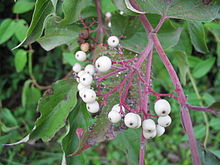Cornus racemosa
| Cornus racemosa | |
|---|---|

| |
| Berries | |
| Scientific classification | |
| Kingdom: | Plantae |
| Clade: | Tracheophytes |
| Clade: | Angiosperms |
| Clade: | Eudicots |
| Clade: | Asterids |
| Order: | Cornales |
| Family: | Cornaceae |
| Genus: | Cornus |
| Subgenus: | Cornus subg. Kraniopsis |
| Species: | C. racemosa |
| Binomial name | |
| Cornus racemosa | |

| |
| Natural range of Cornus racemosa | |
| Synonyms | |
| |
Cornus racemosa, the northern swamp dogwood, gray dogwood, or panicle dogwood, is a shrubby plant native to southeastern Canada and the northeastern United States. It is a member of the dogwood genus Cornus and the family Cornaceae.
Description
Gray dogwood grows 1.2 to 3 m (4 to 10 ft) high, rarely to 8 m (26 ft).[3] It often sends up suckers from underground rhizomes, forming thickets. Its bark is gray and its twigs have white pith. The leaves are 4–8 cm (1+1⁄2–3+1⁄4 in) long and 1–4 cm (1⁄2–1+1⁄2 in) wide, and typically have 3 or 4 pairs of lateral veins, fewer than other dogwood species.[4] The plant grows upright with a rounded habit, oppositely arranged leaves, and terminally born flowers. The white flowers are small, with four petals 2.3 to 3 mm (0.091 to 0.118 in) long, and clustered together in rounded clusters 2.5 to 5 cm (1 to 2 in) wide called diachasial cymes,[4] produced sometime between May and July.[5] After flowering, green fruits (drupes) are produced, and they ripen and turn white from August to October.[5] The flowers and fruit are attached to the plant by bright red pedicels. Many species of birds feed on the fruits.[4] Old branches grow slowly, while new stems are fast growing. In the fall the foliage can take on a reddish or purplish color, though it is not overly showy from a distance.
Classification
Cornus racemosa has been variably treated as a subspecies of Cornus foemina Mill., with which it overlaps.[5]
It occasionally hybridizes with Cornus amomum (silky dogwood), the products of which are named Cornus × arnoldiana.[6]
References
- ^ "NatureServe Explorer 2.0". explorer.natureserve.org. Retrieved 2023-10-24.
- ^ "Cornus racemosa Lam. | Plants of the World Online | Kew Science".
- ^ Coladonato, Milo (1993). "Cornus racemosa". Fire Effects Information System (FEIS). US Department of Agriculture (USDA), Forest Service (USFS), Rocky Mountain Research Station, Fire Sciences Laboratory.
- ^ a b c "Swida racemosa (gray dogwood)". Go Botany. New England Wildflower Society. Retrieved 8 November 2015.
- ^ a b c Murrell, Zack E.; Poindexter, Derick B. (2016). "Cornus racemosa". In Flora of North America Editorial Committee (ed.). Flora of North America North of Mexico (FNA). Vol. 12. New York and Oxford: Oxford University Press – via eFloras.org, Missouri Botanical Garden, St. Louis, MO & Harvard University Herbaria, Cambridge, MA.
- ^ "Cornus × arnoldiana". World Checklist of Selected Plant Families. Royal Botanic Gardens, Kew. Retrieved 2018-07-28.

